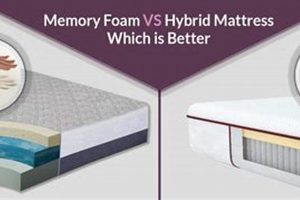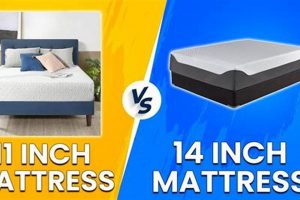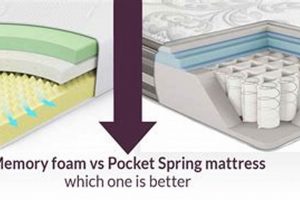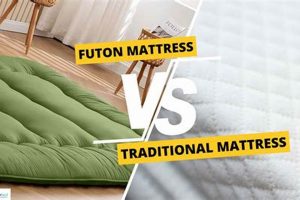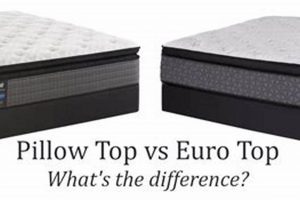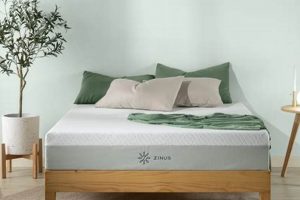The comparison centers around two distinct bedding accessories designed to enhance the comfort and support of a mattress. One is generally thicker, offering a more substantial change to the feel of the sleeping surface. The other is typically thinner, primarily intended to protect the mattress and add a subtle layer of cushioning. For instance, a memory foam layer several inches thick significantly alters the mattress’s contouring and pressure relief, while a quilted cover primarily guards against spills and dust mites.
The selection between these options impacts sleep quality and mattress longevity. A thicker addition can revive an aging mattress, providing improved support and alleviating pressure points. A thinner addition extends the mattress’s lifespan by shielding it from wear and tear, stains, and allergens. Historically, these additions have evolved from simple padding to sophisticated materials designed for specific comfort and health benefits.
Understanding the nuances of materials, thickness, and intended function is crucial when choosing between these bedding enhancements. The subsequent sections will explore the defining characteristics of each type, focusing on their construction, advantages, disadvantages, and suitability for different needs and preferences, providing a clear comparison to aid in informed decision-making.
Selecting Between Bedding Enhancements
Considerations for choosing the appropriate sleep surface modification require careful evaluation. Assessing individual needs and understanding product features is paramount.
Tip 1: Assess Existing Mattress Condition: Examine the current mattress for signs of wear, sagging, or insufficient support. If the mattress offers inadequate support, a thicker enhancement may be necessary. A newer mattress might only require a protective layer.
Tip 2: Define Comfort Preferences: Identify desired changes to the sleeping surface. A preference for a softer feel suggests a thicker, plush option, while a desire for enhanced support indicates a firmer alternative.
Tip 3: Consider Sleeping Position: Side sleepers often benefit from thicker, pressure-relieving materials, such as memory foam. Back and stomach sleepers might prefer a firmer surface with less sinkage.
Tip 4: Evaluate Material Properties: Research the properties of different materials, such as memory foam, latex, down, or synthetic fills. Each material offers unique characteristics regarding temperature regulation, support, and durability.
Tip 5: Determine Budget: Establish a budget range prior to shopping. Prices vary significantly based on materials, thickness, and brand. Balancing desired features with affordability is crucial.
Tip 6: Review Product Specifications: Carefully examine product dimensions and thickness to ensure compatibility with the existing mattress and fitted sheets. Insufficient depth can lead to improper fit and discomfort.
Tip 7: Read Customer Reviews: Research consumer feedback regarding product performance, durability, and comfort. Real-world experiences can provide valuable insights beyond manufacturer claims.
Prioritizing sleep quality and mattress protection is paramount when selecting bedding enhancements. Informed choices, based on thorough assessment and research, lead to optimal sleep experiences.
The subsequent section will delve into specific product recommendations and detailed comparisons, providing further guidance for the discerning consumer.
1. Thickness and Support
Thickness directly correlates to the level of support and contouring offered by a sleep surface enhancement. A thicker addition, such as a mattress topper, generally provides more substantial modification to the existing mattress’s feel. For example, a four-inch memory foam topper conforms significantly to the body, alleviating pressure points and distributing weight more evenly. Conversely, a thinner mattress pad, typically one to two inches thick, offers minimal change to the support characteristics of the underlying mattress. Its primary function is to add a slight layer of cushioning and protect the mattress from wear.
The importance of thickness in determining support is evident in addressing specific sleep-related issues. Individuals experiencing back pain often benefit from thicker toppers with enhanced lumbar support. The additional material can help maintain spinal alignment and reduce discomfort. In contrast, a mattress pad might be sufficient for individuals seeking only to refresh a relatively new and supportive mattress or to protect it from spills and stains. The effect of thickness on support is also influenced by the material used. High-density materials provide greater support at similar thicknesses compared to lower-density alternatives.
Understanding the interplay between thickness and support is practically significant for informed purchasing decisions. Consumers should carefully consider their individual needs and preferences, as well as the condition of their existing mattress, when selecting a sleep surface enhancement. Choosing an appropriate thickness and material composition can significantly impact sleep quality and overall comfort. Overlooking this connection may lead to ineffective solutions or exacerbate existing issues. Therefore, the emphasis on thickness as a key determinant of support is essential for achieving optimal sleep surface modification.
2. Material Composition
Material composition critically influences the performance characteristics of both mattress toppers and pads. The choice of materials directly impacts comfort, support, temperature regulation, and durability. A memory foam topper, for instance, conforms closely to the body, providing pressure relief due to its viscoelastic properties. Conversely, a mattress pad constructed from cotton or polyester primarily offers a thin layer of cushioning and moisture absorption, offering minimal alteration to the mattress’s inherent feel. The selection of materials, therefore, dictates the degree to which the sleeping experience is modified.
The effect of material composition is evident in specific scenarios. A latex topper, derived from natural or synthetic rubber, offers a responsive and resilient surface, providing both support and comfort. Its open-cell structure promotes airflow, mitigating heat retention, a common issue with memory foam. A wool mattress pad, on the other hand, offers temperature regulation through its natural moisture-wicking properties, maintaining a comfortable sleep environment. The type of filling used in a quilted pad, such as down or synthetic fibers, affects its loft and overall softness. In each case, the material directly contributes to the product’s functionality and suitability for different sleep preferences.
A comprehensive understanding of material composition is practically significant for informed consumer choices. Consumers should carefully evaluate the material properties of each option, considering their individual needs and preferences, before making a purchase. The material dictates its lifespan. Ignoring this facet of the selection process may lead to dissatisfaction and necessitate premature replacement. Therefore, an appreciation for the connection between material composition and performance is essential for optimized sleep surface selection.
3. Mattress Protection
Mattress protection constitutes a significant function associated with both mattress toppers and pads, though the level of protection varies considerably. The primary cause of mattress degradation includes the accumulation of dust mites, body fluids, and general wear and tear. A topper, owing to its substantial thickness, forms a more robust barrier against these contaminants, effectively prolonging the mattress’s lifespan. As a practical example, a waterproof topper safeguards the underlying mattress core from liquid spills, preventing staining and potential mold growth. The importance of this protection lies in maintaining hygiene, preserving the mattress warranty (which is often voided by stains), and delaying costly replacements.
In contrast, a pad offers a thinner layer of defense, primarily against surface-level stains and allergens. While it may not prevent deep penetration of liquids, it can be easily removed and laundered, addressing minor spills and reducing allergen buildup. For instance, a quilted pad can capture surface dust and dead skin cells, which are then eliminated through regular washing. The practical application is evident in homes with allergy sufferers, where frequent laundering of the pad mitigates allergen exposure. The selection between a topper and pad for protection hinges on the perceived risk of damage and the degree of desired defense.
In summary, while both toppers and pads contribute to mattress protection, the former offers a more comprehensive shield due to its increased thickness and protective features like waterproofing. The choice depends on the individual’s needs, budget, and the level of protection deemed necessary. The understanding of this distinction ensures an informed decision that effectively extends the lifespan and maintains the hygiene of the mattress, despite some challenges with comfort preferences.
4. Cost Considerations
The economic aspect represents a pivotal factor in the selection between a mattress topper and a mattress pad. Price points vary considerably, reflecting differences in materials, construction, and intended lifespan. Consumers must carefully evaluate budget constraints alongside desired functionality when making a purchasing decision.
- Initial Purchase Price
The upfront cost typically differs significantly. Mattress pads generally command lower price points due to their simpler construction and use of less expensive materials, such as cotton or polyester blends. Toppers, especially those made of memory foam or latex, involve higher manufacturing costs, resulting in a larger initial investment. The implication is that consumers on a tight budget may initially gravitate towards a pad, while those willing to invest more for enhanced comfort and support might opt for a topper.
- Longevity and Replacement Frequency
While a mattress pad may be cheaper initially, its lifespan is often shorter compared to a topper. The thinner construction and less durable materials can lead to quicker wear and tear, necessitating more frequent replacements. Toppers, particularly those of high quality, may last for several years, potentially offsetting their higher initial cost over time. An example is a high-density memory foam topper that maintains its shape and support for five to seven years, compared to a pad that might need replacing every one to two years.
- Maintenance and Cleaning Costs
Maintenance requirements can also influence long-term costs. Some toppers may require professional cleaning or specialized care, adding to the overall expense. Pads are generally easier to maintain, with many being machine washable. The practical implication is that even if a topper offers superior comfort, the ongoing maintenance costs should be factored into the total cost of ownership.
- Impact on Mattress Lifespan
While both options offer some level of mattress protection, the degree of protection and subsequent impact on mattress lifespan can indirectly affect cost. A topper offers a more substantial barrier against spills and wear, potentially extending the life of the underlying mattress. Extending the mattress lifespan delays the need for a costly replacement, indirectly offsetting the investment of the topper. A less expensive pad may offer minimal protection, ultimately leading to premature mattress degradation and replacement.
Ultimately, a balanced assessment of initial purchase price, longevity, maintenance needs, and the impact on mattress lifespan informs the most cost-effective choice. Consumers must weigh these considerations against their individual sleep preferences and budget limitations to make an economically sound decision regarding mattress enhancements.
5. Comfort Adjustment
Comfort adjustment represents a primary motivation for acquiring either a mattress topper or a mattress pad. The selection hinges on the degree of desired alteration to the existing sleep surface and individual preferences regarding firmness, support, and temperature regulation.
- Firmness Modification
Toppers and pads offer differing levels of firmness modification. A substantial topper, particularly one constructed of memory foam or latex, can significantly soften a firm mattress or add a layer of conforming support. Conversely, a thinner pad offers only a slight alteration to the firmness, primarily providing a more cushioned surface without fundamentally changing the support characteristics. For instance, individuals seeking to alleviate pressure points on a firm mattress may opt for a plush memory foam topper, whereas those seeking only a subtle layer of comfort on a moderately firm mattress might choose a quilted pad.
- Support Enhancement
The degree of support enhancement also distinguishes toppers and pads. A topper can enhance support by distributing weight more evenly and preventing sinkage, particularly in areas where the mattress has degraded over time. A latex topper, for example, offers resilient support, promoting proper spinal alignment. A pad provides minimal support enhancement, mainly offering a more comfortable surface feel without addressing underlying support deficiencies. Individuals requiring additional support, such as those with back pain, often find toppers more effective than pads.
- Temperature Regulation
Comfort adjustment also extends to temperature regulation. Certain materials, such as wool or breathable memory foam, can help regulate body temperature, preventing overheating or excessive cooling during sleep. A wool mattress pad, for instance, wicks away moisture, creating a cooler sleep environment. Conversely, some materials, like dense memory foam, can trap heat. The selection of materials in toppers and pads significantly influences the temperature regulation properties, impacting sleep comfort. Individuals prone to overheating may seek out cooling toppers or pads with breathable fabrics.
- Addressing Specific Sleep Needs
Ultimately, the choice between a topper and a pad depends on specific sleep needs. A side sleeper seeking pressure relief on the hips and shoulders may benefit from a conforming memory foam topper. A back sleeper seeking a firmer surface with added support might prefer a latex topper. An individual seeking only to refresh a relatively new mattress and protect it from stains might opt for a simple quilted pad. Aligning the comfort adjustment properties of the topper or pad with individual sleep needs ensures an optimal sleep experience.
In summary, comfort adjustment plays a central role in the choice between a mattress topper and a mattress pad. The selection should align with the desired degree of change to the existing mattress, individual preferences for firmness and support, and specific needs related to temperature regulation and pressure relief. Understanding the impact of each option on these facets of comfort ensures an informed decision that promotes better sleep quality.
Frequently Asked Questions
This section addresses common inquiries regarding the distinctions and applications of mattress toppers and pads, providing factual information to facilitate informed decision-making.
Question 1: What is the primary difference between a mattress topper and a mattress pad?
The primary difference lies in thickness and function. A mattress topper is typically thicker, ranging from two to four inches, designed to significantly alter the comfort and support of the mattress. A mattress pad is thinner, usually one inch or less, primarily intended to protect the mattress and add a slight layer of cushioning.
Question 2: When is it appropriate to choose a mattress topper over a mattress pad?
A topper is appropriate when the existing mattress is uncomfortable due to firmness, lack of support, or pressure points. It is also suitable for extending the lifespan of an aging mattress. A pad is suitable for newer mattresses that require only protection from spills and allergens or a slight enhancement in surface comfort.
Question 3: Do mattress toppers and pads offer the same level of mattress protection?
No. Toppers provide a higher degree of protection due to their thickness and construction. They act as a more substantial barrier against spills, stains, and wear. Pads offer limited protection, primarily against surface-level stains and allergens.
Question 4: Which option is more cost-effective: a mattress topper or a mattress pad?
Cost-effectiveness depends on individual needs and the lifespan of each product. Pads are generally less expensive initially, but may require more frequent replacement. Toppers are more expensive upfront but may last longer and provide greater benefit if the mattress requires significant comfort adjustment or support enhancement.
Question 5: How do different materials affect the performance of mattress toppers and pads?
Material composition significantly impacts comfort, support, and temperature regulation. Memory foam conforms to the body, providing pressure relief. Latex offers resilient support and breathability. Cotton provides a soft and breathable surface. The choice of material should align with individual preferences and sleep needs.
Question 6: Are mattress toppers and pads suitable for all types of mattresses?
Generally, yes. However, considerations should be given to the mattress type and thickness. A very thick topper on an already tall mattress may make it difficult to find fitted sheets that fit properly. Also, for adjustable beds, it’s important to ensure the topper or pad doesn’t hinder the bed’s articulation.
In conclusion, the selection between a mattress topper and a mattress pad requires careful consideration of individual needs, budget, and mattress condition. Understanding the distinctions in thickness, function, materials, and cost facilitates an informed decision that maximizes sleep quality and mattress longevity.
The subsequent section will provide practical tips on selecting the optimal sleep solution.
Mattress Topper vs. Pad
The foregoing analysis has delineated the salient distinctions between a mattress topper and a mattress pad, emphasizing variations in thickness, material composition, protective capabilities, economic considerations, and potential for comfort adjustment. The information presented clarifies that the appropriate choice is contingent upon a precise assessment of individual needs, existing mattress condition, and budgetary constraints. A failure to thoroughly evaluate these factors may result in suboptimal sleep quality and unnecessary expenditure.
Ultimately, selecting between these bedding enhancements necessitates a commitment to informed decision-making. Consumers are encouraged to critically examine their specific requirements and to conduct comprehensive research prior to purchase. The long-term implications for sleep health and mattress longevity warrant a deliberate and thoughtful approach, ensuring the selected option effectively addresses identified needs and contributes to an enhanced sleep environment.


